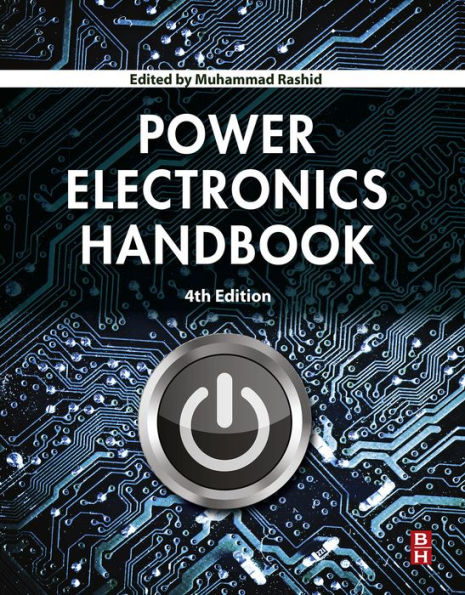Read an Excerpt
Preface
The purpose of Power Electronics Handbook is to provide a reference that is both concise and useful for engineering students and practicing professionals. It is designed to cover a wide range of topics that make up the field of power electronics in a well-organized and highly informative manner. The Handbook is a careful blend of both traditional topics and new advancements. Special emphasis is placed on practical applications, thus, this Handbook is not a theoretical one, but an enlightening presentation of the usefulness of the rapidly growing field of power electronics. The presentation is tutorial in nature in order to enhance the value of the book to the reader and foster a clear understanding of the material.
The contributors to this Handbook span the globe, with fifty-four authors from twelve different countries, some of whom are the leading authorities in their areas of expertise. All were chosen because of their intimate knowledge of their subjects, and their contributions make this a comprehensive state-of-the-art guide to the expanding field of power electronics and its applications covering:
* the characteristics of modern power semiconductor devices, which are used as switches to perform the power conversions from ac-dc, dc-dc, dc-ac, and ac-ac;
* both the fundamental principles and in-depth study of the operation, analysis, and design of various power converters; and
* examples of recent applications of power electronics.
Power Electronics Backgrounds
The first electronics revolution began in 1948 with the invention of the silicon transistor at Bell Telephone Laboratories by Bardeen, Bratain, and Schockley. Most of today's advanced electronic technologies are traceable to that invention, and modern microelectronics has evolved over the years from these silicon semiconductors. The second electronics revolution began with the development of a commercial thyristor by the General Electric Company in 1958. That was the beginning of a new era of power electronics. Since then, many different types of power semiconductor devices and conversion techniques have been introduced.
The demand for energy, particularly in electrical forms, is ever-increasing in order to improve the standard of living. Power electronics helps with the efficient use of electricity, thereby reducing power consumption. Semiconductor devices are used as switches for power conversion or processing, as are solid state electronics for efficient control of the amount of power and energy flow. Higher efficiency and lower losses are sought for devices for a range of applications, from microwave ovens to high-voltage dc transmission. New devices and power electronic systems are now evolving for even more effective control of power and energy.
Power electronics has already found an important place in modern technology and has revolutionized control of power and energy. As the voltage and current ratings and switching characteristics of power semiconductor devices keep improving, the range of applications continues to expand in areas such as lamp controls, power supplies to motion control, factory automation, transportation, energy storage, multi-megawatt industrial drives, and electric power transmission and distribution. The greater efficiency and tighter control features of power electronics are becoming attractive for applications in motion control by replacing the earlier electro-mechanical and electronic systems. Applications in power transmission include high-voltage dc (VHDC) converter stations, flexible ac transmission system (FACTS), and static-var compensators. In power distribution these include dc-to-ac conversion, dynamic filters, frequency conversion, and Custom Power System.
Almost all new electrical or electromechanical equipment, from household air conditioners and computer power supplies to industrial motor controls, contain power electronic circuits and=or systems. In order to keep up, working engineers involved in control and conversion of power and energy into applications ranging from several hundred voltages at a fraction of an ampere for display devices to about 10,000 V at high-voltage dc transmission, should have a working knowledge of power electronics.
Organization
The Handbook starts with an introductory chapter and moves on to cover topics on power semiconductor devices, power converters, applications and peripheral issues. The book is organized into six areas, the first of which includes chapters on operation and characterizations of power semiconductor devices: power diode, thyristor, gate turn-off thyristor (GTO), power bipolar transistor (BJT), power MOSFET, insulated gate bipolar transistor, MOS controlled thyristor (MCT), and static induction devices.
The next topic area includes chapters covering various types of power converters, the principles of operation and the methods for the analysis and design of power converters. This also includes gate drive circuits and control methods for power converters. The next three chapters cover applications in power supplies, electronics ballasts, renewable energy sources, HVDC transmission, VAR compensation, and capacitor charging.
The following six chapters focus on the operation, theory and control methods of motor drives, and automotive systems. We then move on to two chapters on power quality issues and active filters, and two chapters on computer simulation, packaging and smart power systems.
Locating Your Topic
A table of contents is presented at the front of the book, and each chapter begins with its own table of contents. The reader should look over these tables of contents to become familiar with the structure, organization, and content of the book.
Audience
The Handbook is designed to provide both students and practicing engineers with answers to questions involving the wide spectrum of power electronics. The book can be used as a textbook for graduate students in electrical or systems engineering, or as a reference book for senior undergraduate students and for engineers who are interested and involved in operation, project management, design, and analysis of power electronics equipment and motor drives.
Acknowledgments
This Handbook was made possible through the expertise and dedication of outstanding authors from throughout the world. I gratefully acknowledge the personnel at Academic Press who produced the book, including Jane Phelan. In addition, special thanks are due to Joel D. Claypool, the executive editor for this book.
Finally, I express my deep appreciation to my wife, Fatema Rashid, who graciously puts up with my publication activities.
Muhammad H. Rashid, Editor-in-Chief



